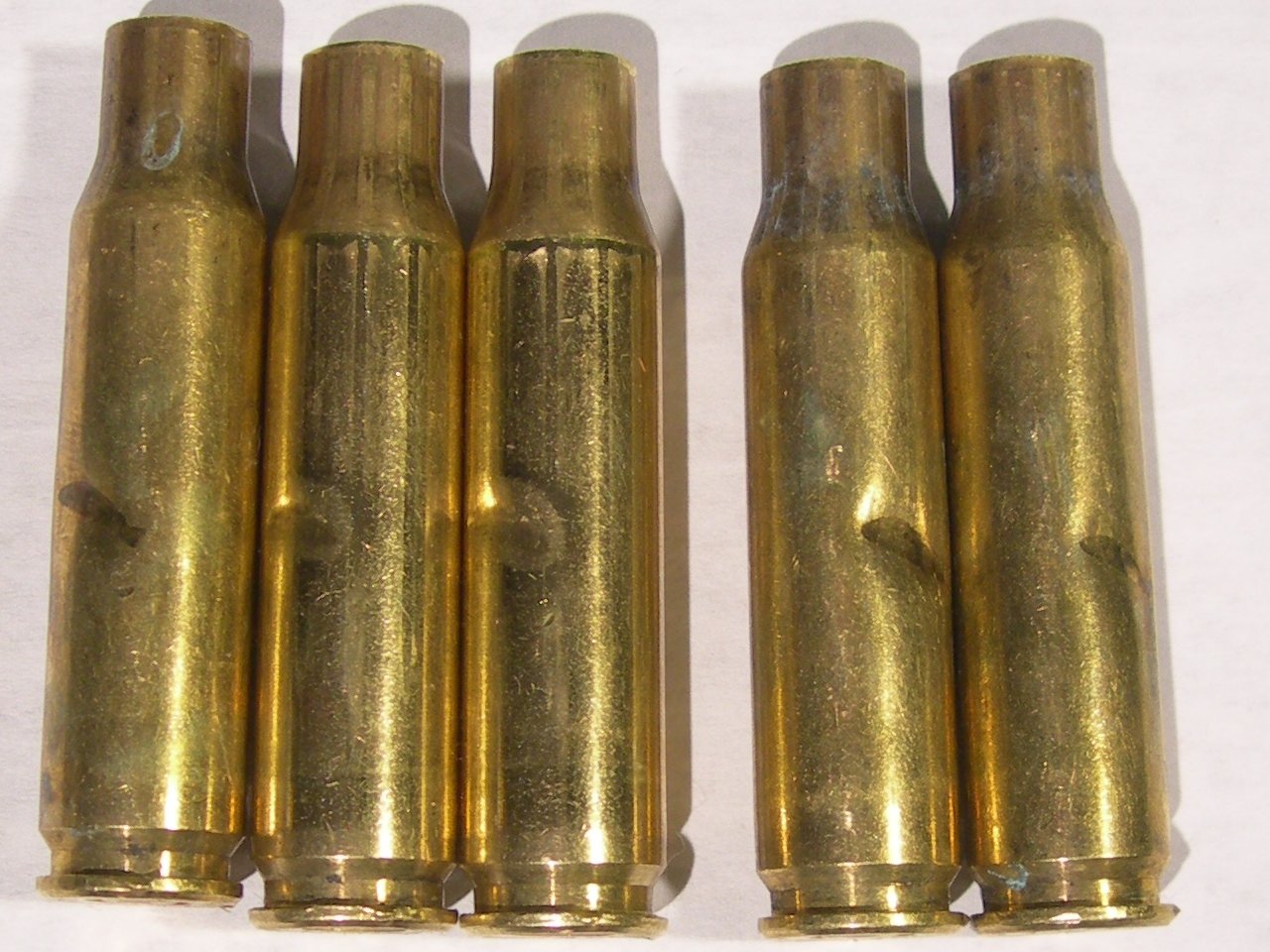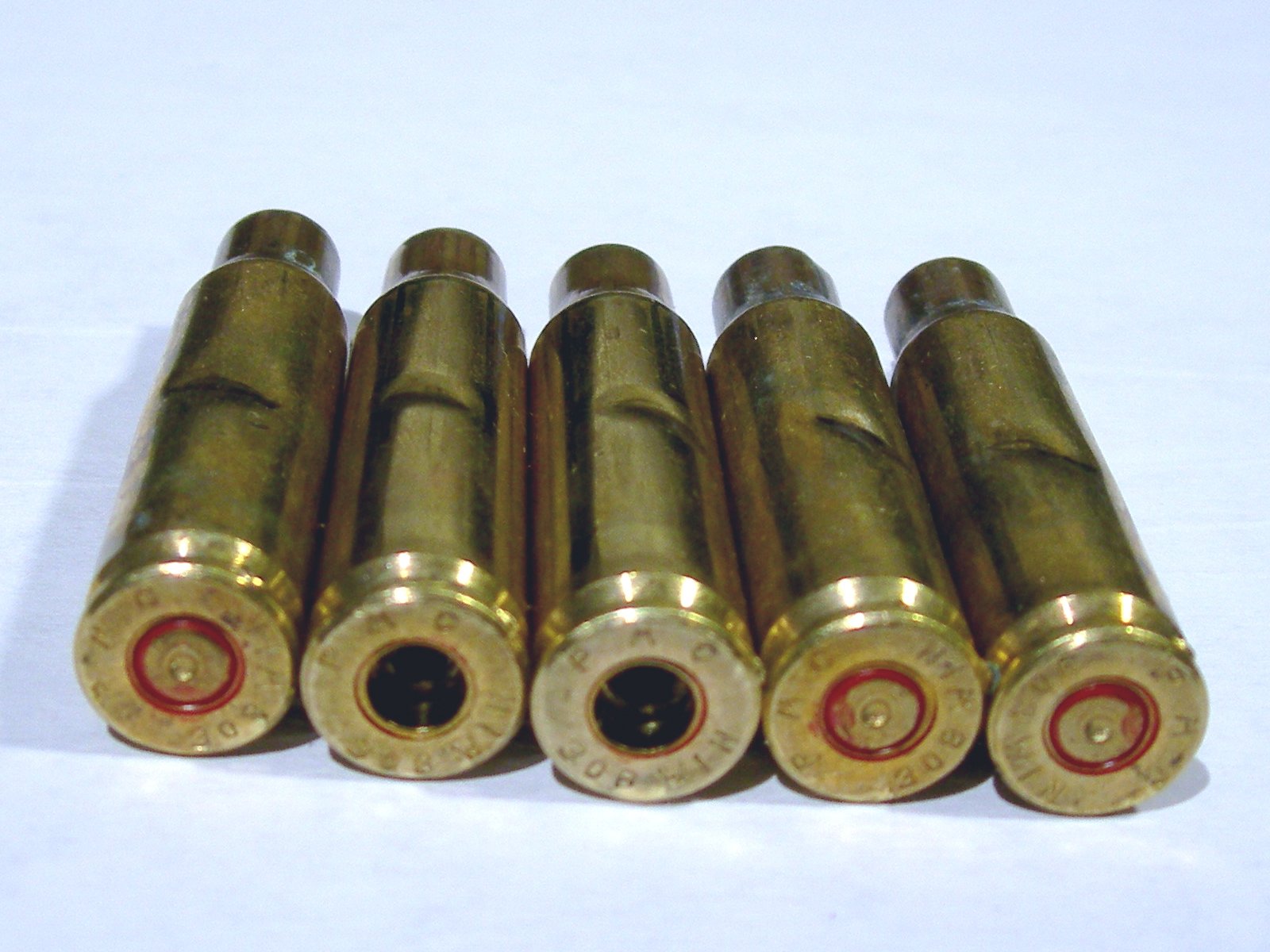I spent some time at the three gun match Saturday scrounging brass off the range between relays. Â Got a whole crapload of .223 off the ground, but was happy to find someone was shooting .308, which I could use to make up a load so I could finally try the FAL I bought from TD. Â I was happy, until I saw what condition it was in:
I was puzzled by what kind of rifle would do this kind of damage to brass. Surely there was something wrong with this guy’s gun. Did the chamber actually have those stripes in it? In the name of John Moses Browning, what kid of crazy gun designer would create a rifle that tortures brass so?
After doing a bit of research, I discovered that this striping was likely caused by the fluted chamber of an HK91 rifle. Â The idea of fluting the chamber is to allow some gas to flow around the cartridge to ease in extraction. Â Apparently early versions of the G3 rifles were ripping the heads off the casing during extraction, so this was the solution to that problem. You can see that in a cutout of the G3 chamber here. Â The roller delayed blowback design of the G3 is just very hard on brass, from both the fluting, and violent extraction. Consensus on cases fired from G3s and its relatives seems to be that they shouldn’t be reloaded. Â The big dents definitely seals the deal. Into the scrap brass bucket they will go.
H&K — Because you suck, and we hate you, especially if you’re a filthy brass scrounging reloader.



As owner of a CETME and some American knockoffs of the HK-91, I recognize that kind of brass and can confirm your deduction. You can install a buffer (basically a pad for the back edge of the ejection port) to stop the side denting if you intend to reload.
Sometimes the FAL will crimp the case mouth, too. Set the gas regulator to just lock the bolt back on an empty magazine.
See if you can find some Winchester White Box 7.62, that should shoot ok.
Regards,
Saigas are tough on cases too.
My Vepr does the same thing to .308 brass.
What would worry me more is the missing primers.
Heh… I decapped those two. I wanted to see how tough they were to decap and resize. The answer is pretty tough.
Reload them. Use a less than max load … the dent will vanish during the next firing.
I thought about that, Kristopher. I would worry how much the denting would create a weak spot on that area. I found folks who said it was fine to reload them too, but more that said no. I figure it’s not too much of a loss to keep looking for better or new brass. Especially considering the penalty of being wrong.
I’ve seen a bunch of brass from an HK rifle, and it was fluted and had the case mouth crunched, The dent in the middle is new to me.
HK must *really* hate you :)
I’ve found other people complaining about the dent, and others who don’t have it, and say it’s fine to reload with the fluting marks. I would reload this stuff if it were just fluted, but the dent scares me. I mean, I’d probably be OK with a light load, but it’s an expensive gamble.
I’ve reloaded the stuff for years. Some cases 4-5 times. One of the other issues is HK/ CETME type extractors put a burr on the extraction rim which you must knock down to check it in a case gauge.
Eagle 1
Eagle:
You agree with the previous commenter that the dent isn’t that big a deal?
I owned two Saiga rifles, .223 & .308. Both models left the “AK dent” in the brass. As stated by a previous poster, a buffer can be purchased to remedy this problem. Not that you own a Saiga, I’m just sayin’.
Maybe I should buy the buffer, and next time I see this guy at the match say “Dude, put this on your rifle so I can scrounge your brass” :) I think at that point it’s time to admit I have a problem.
Don’t scrap that brass, send it to me! That doesn’t look like fluted chamber marks, and it will work just fine in my cast boolit loads. Tony
Have you ever heard about about the rule of chambering a cartridge only twice if you carry a pistol in the condition 1 (mod 1911) and you need to eject it temporarily ? It is said that everytime you load a cartridge from the mag into the chamber the cartridge is diisfigured to the point that if the same cartridge is reloaded more than twice a dangerous situation may be opening up??
I’ve never heard that rule. Chambering doesn’t significantly alter the characteristics of a round, at least if the bullet is seated and the neck crimped properly. Check it with a caliper if you’re concerned, and make sure it’s still in spec after a few chamberings.
I certainly wouldn’t gratuitously chamber and unload rounds, but I wouldn’t worry to much about it. My SOP is to replace carry ammo every six months.
Thank you sire..now I can run and play in the sunshine again…